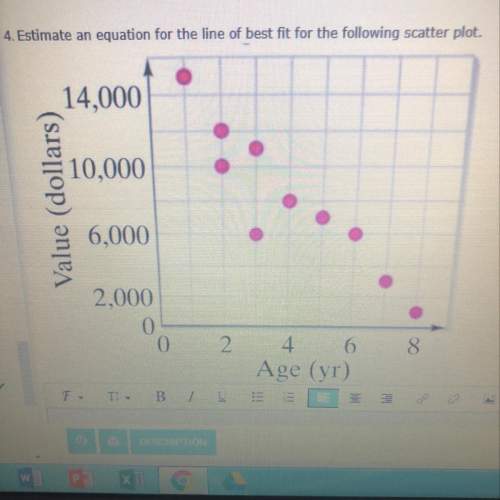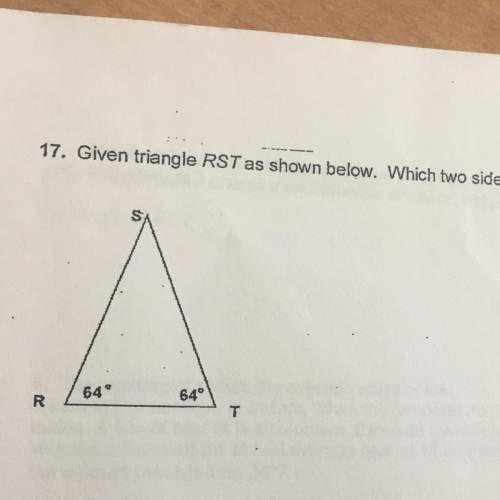
Mathematics, 11.02.2020 21:22 Shelbs01
Interpret the slope. Select the correct choice below and, if necessary, fill in the answer box to complete your choice. A. For every unit increase in bone density, the number of colas decreasesdecreases by nothing, on average. (Round to three decimal places as needed.)B. For 0 colas consumed in a week, the bone density is predicted to be nothing g divided by cm cubedg/cm3. (Round to three decimal places as needed.)C. For a bone density of 0 g divided by cm cubedg/cm3, the number of colas consumed is predicted to be nothing. (Round to three decimal places as needed.)D. For every cola consumed per week, the bone density decreasesdecreases by nothing g divided by cm cubedg/cm3, on average. (Round to three decimal places as needed.) E. It is not appropriate to interpret the slope.

Answers: 3


Other questions on the subject: Mathematics

Mathematics, 21.06.2019 20:30, GreenHerbz206
Tom is the deli manager at a grocery store. he needs to schedule employee to staff the deli department for no more that 260 person-hours per week. tom has one part-time employee who works 20 person-hours per week. each full-time employee works 40 person-hours per week. write and inequality to determine n, the number of full-time employees tom may schedule, so that his employees work on more than 260 person-hours per week. graph the solution set to this inequality.
Answers: 1

Mathematics, 21.06.2019 22:00, rhineharttori
Here is my question! jayne is studying urban planning and finds that her town is decreasing in population by 3% each year. the population of her town is changing by a constant rate. true or false?
Answers: 2

Mathematics, 22.06.2019 00:00, mikemurray115
Triangles abc and dfg are given. find the lengths of all other sides of these triangles if: b ∠a≅∠d, ab·dg=ac·df, ac=7 cm, bc=15 cm, fg=20 cm, and df-ab=3 cm.
Answers: 1

Mathematics, 22.06.2019 02:00, darianhaynes
Study published in the journal of personality and individual differences found that adults with adhd displayed more creative achievement than those who didn't have the disorder. "for the same reason that adhd might create problems, like distraction, it can also allow an openness to new ideas," says holly white, assistant professor of cognitive psychology. "not being completely focused on a task lets the mind make associations that might not have happened otherwise." white and priti shah at the university of michigan gave 60 college students – half of them with adhd – a series of tests measuring creativity across 10 domains. the adhd group scored higher across the board. the adhd group showed more of a preference for brainstorming and generating ideas than the non-adhd group, which preferred refining and clarifying ideas. the adhd status of the participants was established by asking whether the individual had ever been clinically diagnosed with adhd/add. the tests of creativity were pencil-and-paper tasks administered in a laboratory setting. each of the ten scales was comprised of multiple questions, the scores on which were summed (e. g., writing creativity: "how many words can you make from the letters in the word 'psychology' invention creativity: "write down as many uses for a paper clip that you can think of.") this procedure does allow for a participant to be scored as showing no creativity under these conditions. a) state the research question in plain language (i wonder if is related to (1 point) b) state the null hypothesis (1 point) c) state the research hypothesis (1 point) d) is the research hypothesis directional or non-directional (1 point) e) name the predictor / independent variable f) give the operational definition of the predictor / independent variable g) evaluate the construct validity of the predictor / independent variable. (face, procedure, method-match) h) name the outcome / dependent variable i) give the operational definition of the outcome / dependent variable. j) evaluate the construct validity of the outcome / dependent variable. (face, procedure, method-match)
Answers: 1
You know the right answer?
Interpret the slope. Select the correct choice below and, if necessary, fill in the answer box to co...
Questions in other subjects:

Mathematics, 05.05.2020 06:02




Mathematics, 05.05.2020 06:03



Mathematics, 05.05.2020 06:03

Mathematics, 05.05.2020 06:03

History, 05.05.2020 06:03





